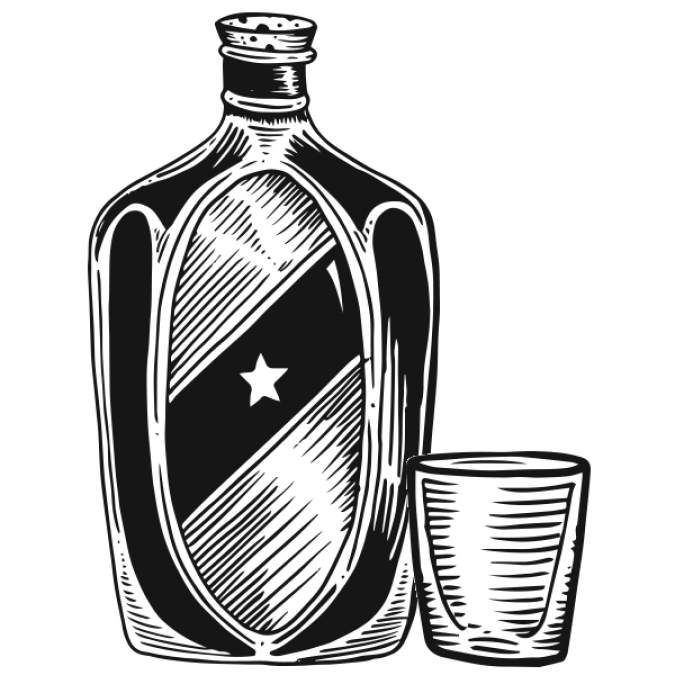Welcome to Part Two of the Home Bar series. By now you’ve had a week to amass the spirits you’ll need to make some of the cocktails highlighted last week: the martini, the Manhattan, the Old Fashioned, the mojito, the lemon drop, the sidecar, and the French 75. Some are well known, others are on their way to becoming classics. Just to reiterate, these cocktails taste best when you squeeze real citrus juice, and all ingredients should be as fresh as possible.
First, the martini. The epitome of class: 007, swanky cocktail parties, and those ever-so-distinctive glasses. Fortunately, the martini is easy to make—just two ingredients and a little mixing. Depending on your preference, pour 2.5 ounces of either gin or vodka into a pint glass and add a half-ounce of dry vermouth and enough ice to fill the glass two-thirds of the way. Stir with a bar spoon; you just want to move the liquid around, not agitate it. This is especially true of gin, infused with many different herbs and botanicals which give it its flavor. When you stir too hard—or, God forbid, shake gin—it becomes cloudy, which can ruin the visual of the super-clean drink. (Of course, some of you out there don’t like vermouth, which is a shame. You can lower the amount or leave it out altogether, but then you’re just drinking cold gin or vodka.) Strain the drink into your favorite martini glass, and add your garnish: an olive or a twist of lemon.
The Manhattan is another cocktail that oozes charm. Whiskey-based, it’s dark, seductive, and a bit bold, just like the place it’s named for. Similar to a martini, it starts with 2.5 ounces of your preferred whiskey: bourbon if you want a rich, slightly sweeter drink, rye if you want it lighter and spicier. Add a half-ounce of sweet vermouth and two or three dashes of Angostura bitters, and stir it over ice. Strain it into a martini glass and add either a preserved cherry or a twist of orange. Do not use those hideous bright-red maraschino cherries you last saw in a Shirley Temple, unless you enjoy the taste of cherry cough syrup. Spring for marasca cherries at a specialty foods store; there’s a world of difference.
I may have been thwarted in my attempt to tell you the story of the Old Fashioned in my first column, but it’s still a classic drink, one that requires a bit more technique than the previous two. Start by shaving a generous piece of orange peel: it’s easiest with a wide vegetable peeler, but you can use a paring knife. Put that in a pint glass with a half-ounce of simple syrup and three dashes of Angostura bitters. Gently press the orange peel with a muddler; the handle of a wooden spoon also works. We’re just releasing the oils in the peel, so be gentle. Add ice and two ounces of rye, stir, and then strain into a fresh glass—a lowball or rocks glass is best. Add ice and garnish with one of those fancy cherries I talked you into buying, or an orange twist . . . or both.
Now we’re getting to the fun stuff. A mojito is just a minty daiquiri, but one that still wows people. Start by taking five or so good-sized mint leaves and placing them in the palm of your hand. Smack your hands together a couple of times, to bruise the mint. If you’re too rough with the mint, it’ll turn bitter. Add a half-ounce of lime juice, three ounces of white rum, and a half-ounce of simple syrup. Shake and garnish with a pretty-looking mint sprig.
The Sidecar is great for people who want something slightly sweet but with a bit more complexity than a lemon drop. Combine two ounces of brandy, a half-ounce of lemon juice, and a half-ounce of Cointreau. Shake and strain into a sugared martini glass. Garnish with a lemon or orange twist.
Lastly, a French 75 makes an excellent aperitif. Start with an ounce and a half of gin and a half-ounce of lemon juice. Shake and strain into either a martini glass or a champagne flute. Fill the glass with sparkling wine and garnish with a lemon twist.
So there you go: six distinct and delicious drinks that you’ve now learned how to make like a pro. The best thing about them is that they can each serve as a template on which you can improvise, by swapping an ingredient out here or there or by changing ratios a bit. We’ll talk a bit more about that in Part Four, but next week Part Three will deal with tools, glassware, and other specialty items.
thebarcode@seattleweekly.com






